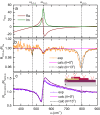Highly confined epsilon-near-zero and surface phonon polaritons in SrTiO3 membranes
- PMID: 38834672
- PMCID: PMC11150425
- DOI: 10.1038/s41467-024-47917-x
Highly confined epsilon-near-zero and surface phonon polaritons in SrTiO3 membranes
Erratum in
-
Author Correction: Highly confined epsilon-near-zero and surface phonon polaritons in SrTiO3 membranes.Nat Commun. 2024 Oct 2;15(1):8545. doi: 10.1038/s41467-024-52983-2. Nat Commun. 2024. PMID: 39358377 Free PMC article. No abstract available.
Abstract
Recent theoretical studies have suggested that transition metal perovskite oxide membranes can enable surface phonon polaritons in the infrared range with low loss and much stronger subwavelength confinement than bulk crystals. Such modes, however, have not been experimentally observed so far. Here, using a combination of far-field Fourier-transform infrared (FTIR) spectroscopy and near-field synchrotron infrared nanospectroscopy (SINS) imaging, we study the phonon polaritons in a 100 nm thick freestanding crystalline membrane of SrTiO3 transferred on metallic and dielectric substrates. We observe a symmetric-antisymmetric mode splitting giving rise to epsilon-near-zero and Berreman modes as well as highly confined (by a factor of 10) propagating phonon polaritons, both of which result from the deep-subwavelength thickness of the membranes. Theoretical modeling based on the analytical finite-dipole model and numerical finite-difference methods fully corroborate the experimental results. Our work reveals the potential of oxide membranes as a promising platform for infrared photonics and polaritonics.
© 2024. The Author(s).
Conflict of interest statement
The authors declare no competing interests.
Figures




References
-
- Caldwell, J. D. et al. Low-loss, infrared and terahertz nanophotonics using surface phonon polaritons. Nanophotonics4, 44–68 (2015).
-
- Campione, S., Brener, I. & Marquier, F. Theory of epsilon-near-zero modes in ultrathin films. Phys. Rev. B: Condens. Matter91, 121408 (2015).
-
- Vassant, S., Hugonin, J.-P., Marquier, F. & Greffet, J.-J. Berreman mode and epsilon near zero mode. Opt. Express20, 23971–23977 (2012). - PubMed
-
- Kinsey, N., DeVault, C., Boltasseva, A. & Shalaev, V. M. Near-zero-index materials for photonics. Nat. Rev. Mater.4, 742–760 (2019).
-
- Berreman, D. W. Infrared absorption at longitudinal optic frequency in cubic crystal films. Phys. Rev.130, 2193 (1963).

